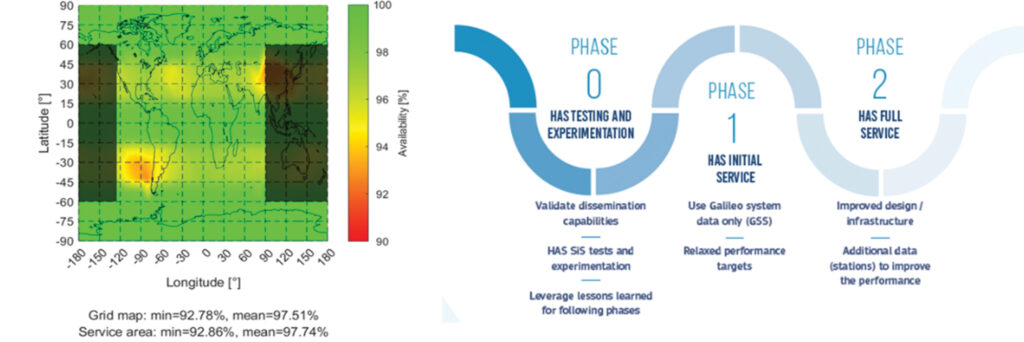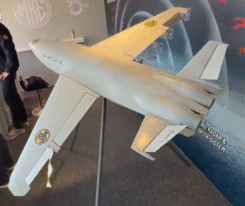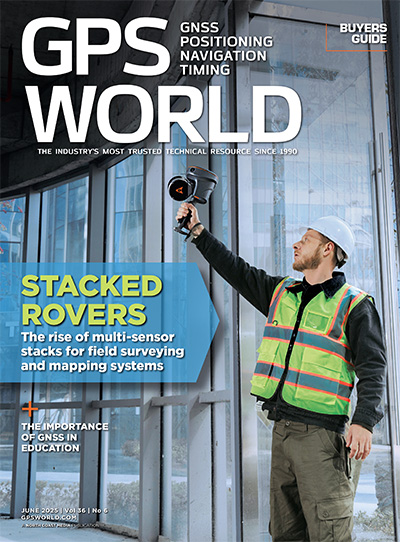New services and capabilities for Galileo


Expansion of Service Portfolio
The service provision teams have been able to focus on improvements to, and expansion of, the Galileo service portfolio.
An update of the Galileo OS SDD was published in Q4 2023. This fourth issue of the OS SDD brought to the users new commitments (e.g., position accuracy at user level, ranging rate accuracy) and improvements of existing minimum performance levels, such as the timeliness of certain Notice Advisory to Galileo Users (NAGU) and GPS-Galileo Time Offset (GGTO) availability. This updated OS SDD also introduced the OS Extended Operation Mode, which is characterized by a gradually degrading ranging accuracy with respect to the nominal operational mode, including in case of outages of Galileo’s ground segment, thus increasing the robustness of the OS.
In addition, Galileo OS users can now benefit from an improved navigation message (I/NAV), being broadcast by the Galileo constellation since mid-2023, which considerably boosts their performance in terms of Time-To-First-Fix (TTFF) and improves the navigation data robustness in challenging environments.
Finally, since June 2024, the Bureau International des Poids et Mesures (BIPM) has included Galileo in its monthly BIPM Circular-T publication, recognizing the excellence of the EU’s GNSS timing measurements and consolidating Galileo’s position as an established and global source of access to accurate and trustworthy UTC.
High Accuracy Service (HAS):
As of the HAS Initial Service declaration (phase 1) on Jan. 24, 2023, Galileo became the first GNSS constellation ever to enable a decimeter-level accuracy, free of charge on a 24/7 basis over most of the globe in nominal conditions. Since the service declaration, EUSPA has been focusing on the engagement of receiver manufacturers for HAS as a top priority.
The adoption rate is excellent — including for automotive, consumer, scientific, timing and space solutions — with an increasing demand for Internet distribution. EUSPA is now proceeding full speed in the preparation for the Full-Service Declaration (phase 2).

Open Service Navigation Message Authentication (OSNMA):
The OSNMA will be a free and open-access service allowing the users to confirm that the received Galileo navigation data has not been modified and originates from the Galileo system, thus increasing the likelihood of detecting spoofing attacks at the data level and significantly contributing to the security of the navigation solution. This is of paramount importance given the increase in the revenue stemming from sales of GNSS receivers and services. This would establish Galileo as the first GNSS provider to deliver authentication service from space.
EUSPA has completed OSNMA testing and is now gearing up for its operational launch. EUSPA and the European Commission jointly published the OSNMA SIS ICD and OSNMA Rx Guidelines updates for the service phase, plus the OSNMA Internet Data Distribution (IDD) ICD update and crypto material, in January 2024. The OSNMA Signal In Space has been transmitted in alignment with these specifications since August 2023. Testing activities have confirmed the readiness of the service. Therefore, the OSNMA SIS ICD v1.1, OSNMA Receiver Guidelines v1.3 and OSNMA IDD ICD v1.1 will be used when the service becomes operational. All cryptographic material to be used is accessible and applicable for the Initial Service provision phase. Many application areas are expected to benefit from this capability, including smart tachographs, telematics and logistics, UAVs, location-based services and timing services.
Galileo Safety of Life (GOSoL):
GOSoL stands for the Galileo contribution to safety of life services, which will cover the provision of Galileo signals and of service guarantees to enable the implementation of Horizontal ARAIM service (H‐ARAIM) supporting aviation users. A first set of commitments was included in OS SDD published in 2023. The service roadmap is currently under definition with a stepwise approach before the operational service is provided.

Galileo Search and Rescue (SAR):
Galileo Search and Rescue service provides accurate, timely and reliable distress alert data to help rescue authorities assist in distress situations (Forward Link Service) as well as acknowledges the receipt of the distress forward link alert to the beacon in distress via the Galileo Navigation Signal in Space (Return Link Service). Galileo SAR is a geographically distributed system which was extended with a fourth European MEOLUT installed in La Reunion, a French island in the Indian Ocean, in operation since November 2022. The new SDD is now ready for publication, providing enhanced commitment to users, notably in the India Ocean area.
Emergency Warning Satellite Service (EWSS):
Utilizing the Return Link Service capabilities, Galileo brings innovations that further contribute to the global emergency space operations as it moves forward toward the implementation phase of the Emergency Warning Satellite Service (EWSS). The EWSS will provide national civil protection authorities with a satellite capability to broadcast on-demand authenticated alerts to a precise target area and to its population directly to any device capable of processing Galileo signals. The EWSS demonstrator was developed and the Galileo Common Alert Message Format has been already published on the GNSS Service Center (GSC) website. The testing phase with the governmental authorities has started, and the preparation activities for the Initial Service Declaration are ongoing. The target markets include smartphones, navigators and public displays.
Still More to Come
Planned developments include:
■ Signal Authentication Service (SAS): User PVT authentication service, based on E6C encrypted ranging and OSNMA authentication navigation data. Initial testing capability and experimentation to start soon.
■ Galileo/SAR Remote Beacon Activation (RBA): Provides authorized users a means to locate aircraft or vessels in emergencies; pilot capabilities for authorized users planned by the end of 2024.
■ Contribution to Ionospheric Prediction (CIP): Delivery of ionospheric products to inform user communities of foreseen under-performance of GNSS signals to be deployed in the next upgrade of the GSC.
■ Two-Way Communication: Enabled by the long Return Link Message based on predefined Q&A, to help the rescue mission.
■ Distress Position Sharing: Rescue centers can contact Galileo to share the position of a beacon user in distress with other nearby users, enabling quicker rescue deployment.
« Prev Page 1 2 3 4 5 Next Page »

















Follow Us